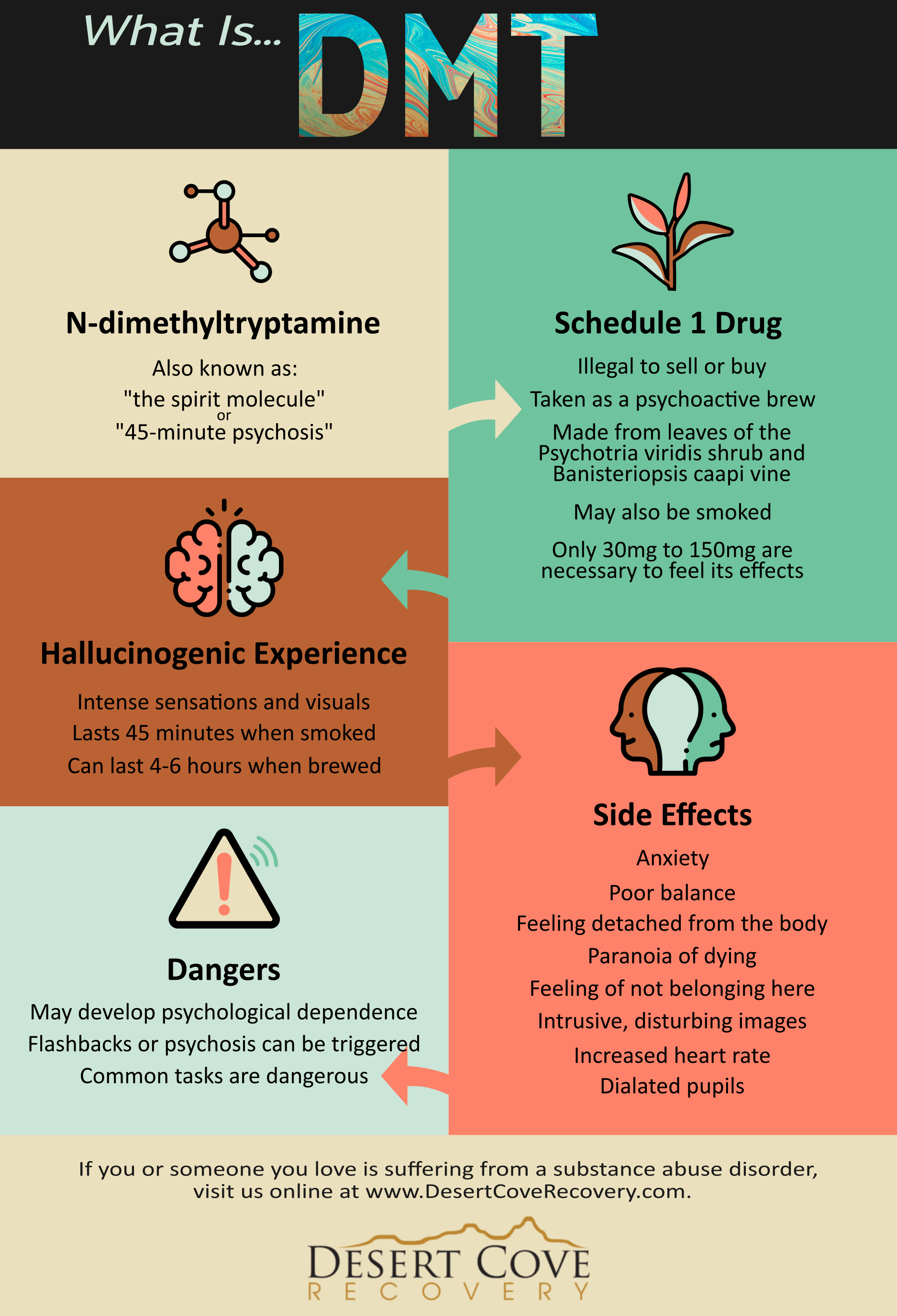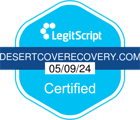Drug Rehab AZ Answers “What is DMT?”
With DMT is on the rise, many individuals are wondering what is DMT? DMT, or N-dimethyltryptamine, is a naturally occurring hallucinogenic compound. It is commonly found throughout South America and parts of Asia. Many call it the “spirit molecule” for the strong hallucinations it causes. One of the names for DMT is the “45-minute psychosis” due to the intense but short duration of its effects. Drug rehab AZ is learning those who are interested in exploring psychedelics are drawn to DMT because it does not last as long as LSD or MDMA.
DMT Basics
DMT is a Schedule I illegal substance in the United States. This means it is illegal for purchase or to sell it. In recent years, DMT and similar drugs have been on the rise in the United States. A 2018 study found tryptamine use among young adults rose from .2 percent to .7 percent between 2008 to 2014.[1]
DMT is mostly consumed as ayahuasca, a psychoactive brew made from the leaves of the Psychotria Viridis shrub and Banisteriopsis caapi vine.[2] The effects of DMT are similar to those of magic mushrooms and LSD. But many people prefer DMT because of the intensity and prolonged duration of its hallucinations.
When smoked, most people take approximately 30mg to 150 mg of DMT and experience its effects almost immediately. An intense hallucinogenic experience peaks by five minutes. The entire high fades within 45 minutes. Drinking a DMT brew results in a more progressive high that begins within 30 to 45 minutes and lasts between four to six hours.
What is DMT Like?
The effects of DMT vary, and there can be intensely different experiences as most people report with psychedelics. However, there are common side-effects of DMT individuals share, many of which are unpleasant and even dangerous. Combined with other substances like alcohol and cocaine, DMT can be life-threatening.
Some of the effects people feel on DMT include:
- Anxiety
- Poor balance
- Feeling detached from the body
- Paranoia of dying or being killed
- An intense feeling of not belonging to this world
- Intrusive thoughts, including disturbing, graphic images.
DMT also elevates blood pressure and increases heart rate. The eyes move faster, and pupils get larger as the drug affects the receptors in the brain controlling eye movement and light reactivity. Enlarged (dilated) pupils are one-way police and medical professionals evaluate someone’s sobriety. There is even a classification system called the Drug Recognition Card that helps officers identify a substance someone has taken based on the diameter of their pupils.[3]
Hallucinogenic drugs may also drive individuals to unsafe situations. Users lose the ability to quickly and easily separate reality from the effects of DMT. Therefore, individuals run the risk of injuring themselves in circumstances that would otherwise be normal daily activities. Simple actions such as cooking and crossing the street can prove more dangerous than the drugs themselves.
Continued after infographic:

The Rise of Psychedelics in Medicine
The use of psychedelic drugs reached its peak in America during the 1960s. Michael Hollingshead, a British researcher known for his research on hallucinogens, introduced American poet Allen Ginsberg and psychologist Tim Leary to LSD. The two are commonly attributed to the widespread popularization of the drug throughout the 60s.
Music festivals like Woodstock became the center stage for LSD experiments. People considered theses experiences life-changing and spiritually awakening. This is the mindset reemerging in the 2020s.
Some people are using psychedelics to treat severe, recurrent depression. Others believe it can help them beat alcoholism. More herald hallucinogenic drugs as the gateway to enlightenment. Actress Gwenyth Paltrow’s Goop Lab documentary on Netflix explored the use of magic mushrooms in Jamaica, a country where their main compound, psilocybin, is legal.
The trend is not solely explorative in New Age communities, however. In January 2020, the Food and Drug Administration approved a program to test the efficacy of MDMA-assisted psychotherapy for veterans with PTSD.[4] The Multidisciplinary Association for Psychedelic Studies, which funded the study, has been in operation since 1986, one year after MDMA was made illegal.
But psychedelics such as LSD and DMT are not magical in any way. Despite the hallucinations they induce, they will not cure any mental or physical illness. They can also trigger flashbacks or trigger the onset of psychosis.
Is DMT Addictive?
Despite the rise in psychedelic use, DMT is relatively uncommon in America. There are few studies and no evidence to suggest taking DMT causes physical dependency. However, psychological dependency is still possible. If someone takes DMT with other substances, their physical health will be at a much higher risk along with the likelihood of developing an addiction.
For anyone who has a DMT or substance abuse problem, the best course of action is to seek out a medical professional. Early intervention can prevent negative and even permanent side-effects, as well as stop someone from developing other psychological disorders.
If you or a loved one is suffering from substance abuse, a drug rehab AZ can help. Please contact Desert Cove Recovery today to learn more.
Sources:
[1] https://www.ncbi.nlm.nih.gov/pmc/articles/PMC6182767/ [2] https://www.healthline.com/nutrition/ayahuasca [3] https://www.theiacp.org/drug-recognition-experts-dres [4] https://maps.org/news/media/8008-press-release-fda-agrees-to-expanded-access-program-for-mdma-assisted-psychotherapy-for-ptsd


